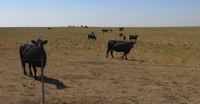Use Trigger Dates as Drought Decision Making Guide
(Click the image below to view a high-resolution image that can be downloaded)
As drought continues to affect much of the western U.S. and North Dakota, ranchers will make management decisions that deal with the land, livestock and even people.
“Based on the lack of fall moisture in 2020 and snow this winter, the odds for a negative impact on forage production of pastureland and hay land in 2021 is more likely than not,” cautions Kevin Sedivec, North Dakota State University Extension rangeland management specialist.
“We need to remember that drought conditions are common in the northern Plains,” he adds “We know 70% to 80% of our forage production is driven by moisture that occurs by early July in the Dakotas and by late June in eastern Montana and Wyoming.”
Tools available to help predict forage production include:
- NDSU Forage Prediction Calculator: https://www.ag.ndsu.edu/drought/forages-and-grazing
- Grass-Cast: https://grasscast.unl.edu
Producers also know most of their hay is harvested by early July.
“The lack of snow creates different concerns,” says Miranda Meehan, NDSU Extension livestock environmental stewardship specialist. “Many stock ponds and dams rely on snowmelt runoff for recharge. Without recharge, these livestock drinking water sources will become low, creating water shortage and potentially deadly water.”
Total dissolved soluble (TDS) and sulfate levels can reach toxic levels when water levels are low. High levels of TDS and sulfates lead to herd health issues and low calf weights.
Another concern with low water levels is that cattle can become stuck in the mud.
Here is a decision guide for livestock producers based on trigger dates to plan for drought impacts:
April 15-30
- Assess pasture drinking water conditions. Test water quality for TDS, sulfates and nitrates. Water quality should be monitored as long as drought conditions persist. Make sure the water supply is adequate and have a strategy in place when the water levels become low or toxic.
- If drought conditions occur throughout April, the growth of introduced cool-season pastures (crested wheatgrass, smooth brome grass) will be below average. If lower production is expected, delay cattle turnout and feed hay longer, evaluate alternative feeds available or plan for fewer grazing days. If these grasses comprise hay land, expect below-average production and plan to grow emergency feed or purchase hay. The earlier you purchase hay, the most economical the prices will be. If hay is in short supply, prices often double by the fall.
- Evaluate stand quality and probable forage production of winter cereal crops used for grazing or haying purposes. The lack of snow cover increases the risk of winterkill on winter cereals and alfalfa.
May 1-31
- If drought conditions occur in May, expect reduced forage production of 10% to 40% or more, depending on the severity of the drought. Plan for removing cattle earlier, reducing the stocking rate or weaning calves early. Plan for alternative forages or feeding options if none of the above are desired. Plan to begin grazing tame pastures or post-contract Conservation Reserve Program lands if available.
- Continue to assess the water sources.
June 1-30
- If drought conditions occur in June, expect reduced forage production of 30% to 70% or more, depending on the timing and amount of rain, severity of the drought and past management. Plan for removing cattle earlier, reducing the stocking rate, weaning calves early or culling cows. Assess the establishment and stand quality of summer annual forages and soil moisture conditions.
- Graze pastures that have drinking water shortages later in the grazing season, saving pastures with better water resources for summer use.
- If hot, dry conditions persist, monitor dugouts and ponds for cyanobacteria (blue-green algae), which is toxic to livestock. Restrict livestock’s access to the water if it is toxic.
- Take precautions to prevent nitrate poisoning because some plants accumulate nitrates during periods of drought.
- Maintain a monitoring plan to measure utilization and minimize overgrazing.
- Continue to assess the water sources.
July 1-30
- If drought conditions persist throughout July, expect reduced forage production of 50% or more, depending on the severity of the drought. Plan for removing cattle earlier, culling cows, weaning calves early or moving to alternative forages or crop residue earlier than planned.
- Assess the establishment and stand quality of late-planted summer annual forages and soil moisture conditions.
- Maintain a monitoring plan to measure utilization and minimize overgrazing.
- Assess current year and carryover winter feed inventories. Purchase hay resources as needed.
- Continue to assess the water sources.
Aug. 1-30
- If drought conditions persist throughout August, expect reduced forage production of 70% or more because plant growth will die off earlier than normal and standing feed will be reduced. Expect lower-quality feed and lower cow performance unless cattle are supplemented with high-quality feed.
- Maintain a monitoring plan to measure utilization and minimize overgrazing.
- Continue to assess the water sources.
Sept. 1-30
- Make a final assessment of the yield of annual forages grown for late-season grazing.
- Inventory other harvested feed and determine the quantity of crop residue on cropland.
- Estimate the amount of forage in winter pastures.
- Maintain a monitoring plan to measure utilization and minimize overgrazing.
- Continue to assess the water sources.
Oct. 1-30
- Use September through October precipitation to predict stocking rates for the next growing season. Start planning for future needs and changes.
“Having a plan in place with well-defined trigger dates for implementing drought management strategies will help you get through the drought and minimizes losses,” Sedivec says. “The longer you wait to make management decisions, the fewer option will be available and the greater the risk for losses.”
These resources can help producers develop a plan to fit their operation:
- https://www.ag.ndsu.edu/publications/livestock/strategies-for-managing-drought-in-the-northern-plains
- http://drought.unl.edu/ranchplan/Overview.aspx
NDSU Agriculture Communication - Feb. 1, 2021
Source: Kevin Sedivec, 701-424-3606, kevin.sedivec@ndsu.edu
Source: Miranda Meehan, 701-231-7683, miranda.meehan@ndsu.edu
Editor: Ellen Crawford, 701-231-5391, ellen.crawford@ndsu.edu


